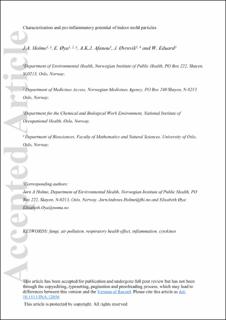| dc.contributor.author | Holme, Jørn Andreas | |
| dc.contributor.author | Øya, Elisabeth Tveiten | |
| dc.contributor.author | Afanou, Komlavi Anani | |
| dc.contributor.author | Øvrevik, Johan | |
| dc.contributor.author | Wijnand, Eduard | |
| dc.date.accessioned | 2020-04-16T08:02:37Z | |
| dc.date.available | 2020-04-16T08:02:37Z | |
| dc.date.created | 2020-03-05T10:08:39Z | |
| dc.date.issued | 2020 | |
| dc.identifier.citation | Indoor Air: International Journal of Indoor Environment and Health. 2020, . | |
| dc.identifier.issn | 0905-6947 | |
| dc.identifier.uri | https://hdl.handle.net/11250/2651234 | |
| dc.description.abstract | A number of epidemiological studies find an association between indoor air dampness and respiratory health effects. This is often suggested to be linked to enhanced mold growth. However, the role of mold are obviously difficult to disentangle from other dampness related exposure including microbes as well as non‐biological particles and chemical pollutants. The association may partly be due to visible mycelial growth and a characteristic musty smell of mold. Thus, the potential role of mold exposure should be further explored by evaluating information from experimental studies elucidating possible mechanistic links. Such studies show that exposure to spores and hyphal fragments may act as allergens and pro‐inflammatory mediators, and that they may damage airways by the production of toxins, enzymes and volatile organic compounds. In the present review, we hypothesizes that continuous exposure to mold particles may result in chronic low‐grade pro‐inflammatory responses contributing to respiratory diseases. We summarize some of the main methods for detection and characterization of fungal aerosols and highlight in vitro research elucidating how molds may induce toxicity and pro‐inflammatory reactions in human cell models relevant for airway exposure. Data suggest that the fraction of fungal hyphal fragments in indoor air is much higher than that of airborne spores, and the hyphal fragments often have a higher pro‐inflammatory potential. Thus, hyphal fragments of prevalent mold species with strong pro‐inflammatory potential may be particularly relevant candidates for respiratory diseases associated with damp/mold‐contaminated indoor air. Future studies linking of indoor air dampness with health effects should assess the toxicity and pro‐inflammatory potential of indoor air particulate matter, and combined this information with a better characterization of biological components including hyphal fragments from both pathogenic and non‐pathogenic mold species. Such studies may increase our understanding of the potential role of mold exposure. | |
| dc.language.iso | eng | |
| dc.title | Characterization and pro‐inflammatory potential of indoor mold particles | |
| dc.type | Peer reviewed | |
| dc.type | Journal article | |
| dc.description.version | acceptedVersion | |
| dc.source.pagenumber | 20 | |
| dc.source.journal | Indoor Air: International Journal of Indoor Environment and Health | |
| dc.identifier.doi | 10.1111/ina.12656 | |
| dc.identifier.cristin | 1799757 | |
| dc.relation.project | Norges forskningsråd: 196130 | |
| cristin.ispublished | true | |
| cristin.fulltext | postprint | |
| cristin.qualitycode | 1 | |
